#fastnet – "The Gull was a plank-on-edge cutter of ancient vintage. She had a tremendous jackyard topsail, a terrific tiller, and a pack of wild Irish men aboard her, who flogged the life out of her. As I recall, we were either first or second around the Fastnet. Shortly thereafter the mainsail started letting go and water came up over the floor-boards because we'd spewed all our bow caulking. The glass dropped .80 inches in forty-five minutes, and on that came a regular Bristol Channel howler."
Thus is Harry Donegan of Cork and the Gull's involvement in the Fastnet remembered, in this opening to a piece of international sailing journalism written after the second Fastnet Race of 1926 by Warwick Tompkins. He was an American who was so keen to do this recently inaugurated challenge that he inveigled his way into Gull's crew by what was virtually a pierhead jump shortly before the start.
But he and his skipper and new shipmates hit it off well, and subsequently his own seafaring career blossomed with his thirty years of voyaging aboard the schooner Wander Bird recorded in print and on film. His family were raised totally afloat, such that one of his sons, Warwick Jnr, was a renowned sailor invariably known as Commodore Tompkins who commented that his life had been lived back to front. Most sailing enthusiasts learn how to live on boats as they mature into an appreciation of cruising and the voyaging life. But Commodore Tompkins eventually had to learn how to live ashore, even though he continued sailing.
However, the name of Tompkins first came to sailing prominence through his father's vivid picture of Harry Donegan and his crew of Corkmen in the Gull in 1926. It says much for the power of Warwick Snr's writing that his account has the ring of a greater truth to it, despite the fact that it has certain inescapable inaccuracies. And we can rightly consider such things this morning as today in Cowes, Jamie Donegan (22) - great-great-grandson of Harry Donegan - is making final preparations with his shipmates aboard Anthony O'Leary's Ker 39 Antix to race his first Rolex Fastnet Race, sailing as bowman.

Anthony O'Leary Ker 39 Antix Photo by Bob Bateman
With a record fleet of 380 boats tomorrow – including a turnout of twelve Irish boats – the early Fastnet Races with their modest fleets have now acquired an almost mythological status. Each detail is lovingly picked over and analysed every which way, while the continuing and healthy survival of Jolie Brise, the 1913-built pilot cutter which won the first race of 1925, is a matter of awe. This was seen last month in Glandore was she was the superstar of the Classic Boat Regatta in this her Centenary year, with her ceremonial rounding of the Fastnet Rock a quasi-religious event.

A very special event – the historic Jolie Brise, winner of the first Fastnet Race in 1925, approaches the Fastnet Rock in her Centenary Year during Glandore Classic Regatta last month. Photo: Brian Carlin
So what's the beef about old man Tompkins' Gull story? Simple enough. It's a slander on a fine yacht to describe her as "a plank-on-edge cutter of ancient vintage." She was no such thing. When Harry Donegan bought her in Cork Harbour in 1921, she was one of the shrewdest yacht-purchasing decisions ever seen about the place. For the handsome Gull had been designed in 1896 by the legendary Charles E Nicholson when he was aged 28, and starting to come into his prime as the greatest English yacht designer. Nicholson had been designing yachts of all sizes for construction by the family firm of Camper & Nicholson since at least 1892, and by 1896 he had moved very far indeed from the plumb bow, plank-on-edge leadmines of the 1880s.
With 10.1ft beam on her overall hull length of 44ft, many would have considered Gull quite beamy when she first appeared. But she did set a truly enormous gaff rig, and in order to hold it up the shrouds were given extra power by the chainplates being on channels to widen the angle. For stylish yachts in 1896, channels for the chainplates were rather old-fashioned, and for an American like Tomkins who associated such things with ancient working schooners, they gave a false impression of antiquity. But the fact is that at the time of the 1926 Fastnet, Gull was only thirty years old. Quite mature perhaps, but never "ancient vintage".
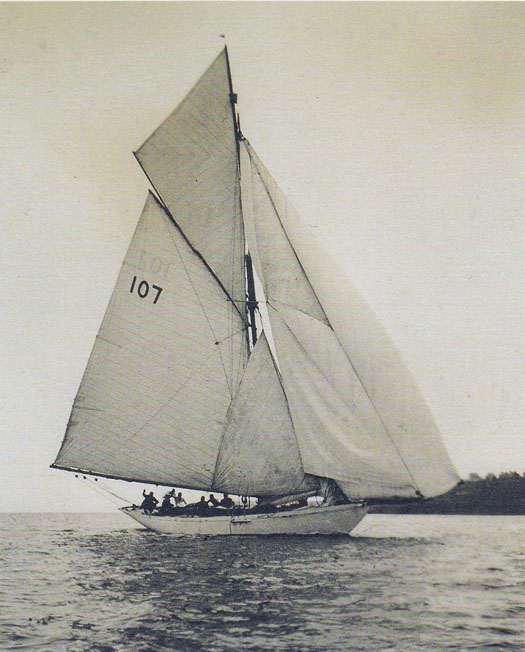
Gull in her prime. She was a fine creation by Charles E Nicholson when he was aged 28 in 1896, and beginning to make his mark as a major yacht designer. Photo courtesy Royal Cork YC.
Ironically, during the current Cowes Week, Jamie Donegan has been one of the "pack of wild Irishmen" sailing (and very successfully too) with Adam Gosling aboard the Corby 36 Yes!. Back in the day - and it's now quite a long time ago - the current Yes! was the ground-breaking Mustang Sally, first owned and campaigned with exceptional success by Peter Wilson of Howth. For many of us, Mustang Sally was and is the definitive Corby design, and it's great to see her today in superb order in loving ownership, and still in the frame. But the quite narrow Mustang Sally (as was) is now nearly twenty years old, comparable to Gull's age when Harry Donegan bought her when you also remember she'd been out of commission during the 14-18 War. Yet it would be absurd to describe Yes! as "a plank-on-edge sloop of ancient vintage".
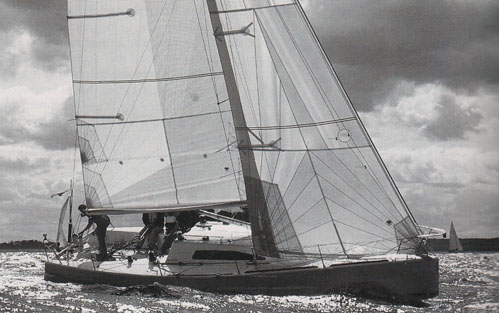
Mustang Sally in Peter Wilson's successful ownership. In June 1995 she won every race she entered, including (this photo) the Howth YC Centenary Regatta. Photo Rick Tomlinson/Courtesy HYC
That said, the huge rig on Gull took its toll which aged her before her time, and it gives us an excuse to run Warwick Tompkins' rollicking piece in full:
"The Gull was a plank-on-edge cutter of ancient vintage. She had a tremendous jackyard topsail, a terrific tiller, and a pack of wild Irish men aboard her, who flogged the life out of her. As I recall, we were either first or second around the Fastnet. Shortly thereafter the mainsail started letting go and water came up over the floor-boards because we'd spewed all our bow caulking. The glass dropped .80 inches in forty-five minutes and on that came a regular Bristol Channel howler.
In thick weather we groped for Baltimore, and when we got within what we estimated to be two miles and could not pick up the light, we reluctantly gave up the heroic idea of beaching the Gull there, caulking her, and still finishing. (Yes, that's the sort of Skipper and crew it was!) We hauled off to Queenstown (Cobh). We were close hauled under tri-sail and storm jib with the wind coming now from about the sou'east and the delightful Irish coast altogether too close under our lee.
The seas were breaching clean over the old packet, and the spitfire jib -- though we didn't know it—was pulling the runner eyebolt right out of the counter. We passed the Stag Rocks and they weren't more than two hundred yards to leeward; on the darkest, wildest sort of night they were plainly visible and audible, great and terrifying founts of spray just to leeward. It was possibly the closest escape I've ever had at sea and one of the few times my life has actually been in danger.
Well, the old bucket held together until we put her on the mud at Cobh in the morning. All hands had pumped bailed and cursed – I didn't hear any praying – all night long, and everything on board was soaked. When the mess was drying out in the sunlight this final morning I found my bedraggled, red-eyed, but still spunky little skipper fiddling around on deck with what looked to me suspiciously like a boy's toy. I asked him what he was doing, and his answer, s'helpmegawd, was:
"I'm flying a kite".
He went on to explain that he had meant to test out a theory that an aerial could best be carried by a kite when at sea, and so he had brought along a box-kite which he had forgotten until we started heaving gear on deck. Discovering it at this late date his intellectual curiosity remained strong enough to overcome the anxiety, desperate work and weariness of a rotten hard race and near-foundering. His name is Harry P.F. Donegan, a solicitor of Cork, and one of the world's best."
Corkmen will if course tell you that down Munster way, there's much more meaning to "flying a kite" than simply putting a toy aloft. And as for Harry Donegan being "one of the world's best", Warwick Tompkins had further reason for thinking so. In 1926, the only qualification for membership of the nascent but already prestigious Ocean Racing Club was completing a Fastnet Race. Harry Donegan and his crew were already members after coming third with Gull in the inaugural race the previous year. But that had been a relatively gentle affair, and Donegan reckoned that Tompkins was now every bit as qualified. So he gathered up the American, piled aboard the Cork-Swansea ferry that night with him, caught a series of trains to Plymouth next day, and that night at the post-Fastnet dinner, Donegan made an impassioned speech in support of Warwick Tompkins' right to RORC membership, which was carried with acclamation.

Harry Donegan aboard his beloved Gull
Harry Donegan (1870-1940) was in his way quite a force in sailing, and in the life of Cork and Ireland. A small man of notable energy, he was playing a key role in Cork Harbour sailing from an early age. When the plans for the new Cork Harbour One Designs were being discussed with William Fife in 1894-85, Donegan was secretary to the owners' group, and though he never owned a CHOD himself, he was renowned as helmsman in the class, and as an amateur painter he also recorded their earliest appearances.
But cruising and offshore sailing were his greatest passion, and he made some coastal ventures in very small craft. By 1912 he had produced pioneering harbour and anchorage plans for the magic places of West Cork, and this early interest in sailing directions was part of his enthusiasm for the notion of an Irish Cruising Club, though it was 1929 before he and a friend met while cruising west Cork, Billy Mooney of Howth, were finally able to bring the ICC into being.
In 1920, the Cork Harbour cruiser fleet acquired a handsome addition, the 18-ton Nicholson cutter Gull, bought in the southwest of England. For some reason, whoever brought her to Cork had to sell her the following year, and thus in 1921, Harry Donegan acquired his dreamship, the sailing love of his life.
These were difficult times in Ireland, with the country emerging from the War of Independence only to be plunged into the Civil War of 1922, fought over the acceptance or rejection of the Treaty which had ended the War of Independence. Initially, the anti-treaty forces had control of Cork, but as the summer of 1922 progressed, the Government's pro-treaty forces under the command of Emmett Dalton gradually closed in to free the southern capital.
Communications between Dalton and his commander Michael Collins in Dublin were becoming increasingly difficult as roads, railways and telegraph lines between the two cities were disrupted by anti-treaty guerilla groups. A system had been worked out whereby communications between Dalton and Collins were carried personally by Collins' feisty sister, Mary Collins-Powell. But when all usual means of getting her to Dublin with the vital dispatches were finally gone, Harry Donegan offered to sail her aboard Gull to Rosslare Harbour, where the east coast railway was firmly under government control all the way to Dublin.
For this venture in early August 1922, he assembled a crew of many professional talents. Harry Donegan was a solicitor, his first mate was Dr Gerald Ahern the local doctor, and in their sailing and any spiritual needs, they were helped by the third crewman, Fr Donal Murphy O'Connor.
Easterly winds hampered their progress towards Rosslare, but fortunately Government-controlled Waterford offered taxi communication with Rosslare, so they peeled off into port and soon the dispatches were in Dublin and Gull cruised back to Crosshaven. With the situation clarified for the general staff in Dublin, plans could be finalized for the freeing of Cork, and Emmett Dalton and his men soon had the job done.
Which was just as well for our three heroes on the Gull. While the city may have been coming rapidly under Government control, down to the south the countryside was still full of anti-treaty units. It was Civil War in all its horror of brother against brother, friend against friend. When the crew of Gull came ashore in Crosshaven after their successful little voyage, they were promptly captured by a local anti-treaty group, and imprisoned for some days in a shed.
But up in Cork, Emmett Dalton and his fellow commanders were going about their business with such efficiency that in Crosshaven the solicitor, doctor and priest - sailors all - were soon released unharmed. Peace returned to Cork Harbour. But as the main theatre of the Civil War moved ever more remorselessly towards its bloody denouement in West Cork, Michael Collins felt he could no longer be up in Dublin, remote from events in his home county. Despite everyone else advising against it, he came to Cork to be with his men. He spent his final night in the Imperial Hotel in Cork, and with that city already showing signs of its civilized normality, who knows but he may have had time to meet up with Harry Donegan, for everyone in Cork knew everyone else, then as now.
Next day, the Commander-in-Chief headed west on his tour of inspection, and by evening General Collins was dead, killed during a spirited exchange of fire in which he personally got involved following an ambush by men who would have been his comrades-in-arms during the War of Independence.
The Civil War was already being won by the pro-Treaty forces, but the death of Collins undoubtedly speeded its ruthless conclusion. By 1923, Ireland was very determinedly getting back to normality. In its own way, sailing made its contribution. In Dublin, self-taught yacht designer John B Kearney started construction on his masterpiece, the 38ft yawl Mavis. From Foynes on the Shannon Estuary, Conor O'Brien departed in his 40ft Saoirse – newly-built to his own design in Baltimore, West Cork - to sail to Dun Laoghaire to begin what was to become his epic pioneering voyage, round the world in two years south of the great Capes.
And in Crosshaven, Harry Donegan kitted out the Gull to make a long cruise to the west coast of France which so clearly demonstrated the yacht's speedy sea-keeping ability that when, in 1924, the notion was being aired of the new 630 mile ocean race from the Solent out to the Fastnet Rock, then back to a finish at Plymouth, Harry Donegan became one of its most enthusiastic proponents.
In that first race, the sailing establishment in Cowes wanted nothing to do with this contentious new challenge, so it was started eastward out of the Solent from Ryde. It was 1926 before the Fastnet was accepted by the RYS for the "traditional" westward start from Cowes, a point often forgotten in comparing record times, as the first race was about twenty miles longer. Be that as it may, Gull was one of the seven starters, and though she was by no means the newest (Jolie Brise was only a dozen years old), Charles E Nicholson had done his work well. Gull had much the most modern hull in the entire Fastnet flotilla, and with her huge if archaic rig, she was fastest in anything up to Force 4.
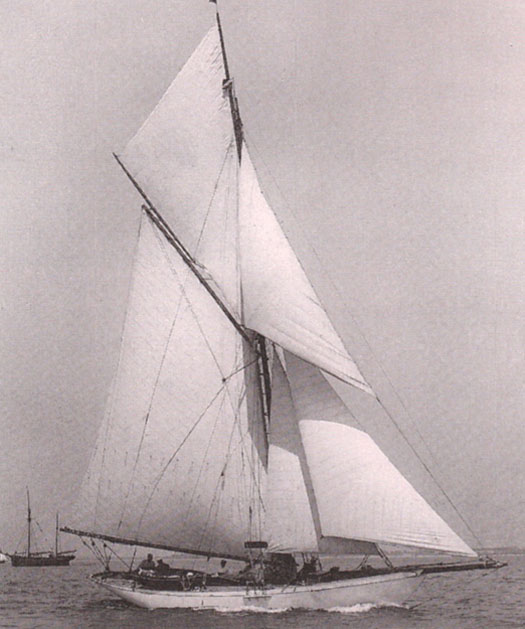
Gull at the start of the first Fastnet Race, August 15th 1925. She led overall for the first third of the race
Thus she led by a good margin going outwards past the Scillies, but with sailing power soon lessened through broken topsail halyards, the succeeding stages weren't so happy, and Jolie Brise was first to the Fastnet with time in hand on the Irish boat. Heading back towards Plymouth, a navigational error brought Gull in north of Land's End in fog, and by the time she'd made good this mistake in strong onshore winds, Jolie Brise – which was allowing her 9 hours on handicap – was well into Plymouth the winner, second went to the Royal Engineer's determinedly-sailed 38ft gaff cutter Fulmar, and third was Gull.
These days with talk (God forbid) of making the Fastnet an annual event as it is clearly so popular, we have to remember that back in the 1920s and early 30s, it took real determination to keep it going at all, first as an annual event, and then after 1931 as biennial. Certainly there were those for whom, having done the first race of 1925, doing it again was of no interest. But Harry Donegan was one of those who considered participation in the 1926 race was essential, even if he was now 56 years old and no longer in perfect health.
But the fact that he willingly took Warwick Tompkins aboard as a last-minute addition to the crew suggests that he may have had difficulty in assembling a full ship's complement back home. And the race was now acquiring further contentious issues. There were those who still said it shouldn't happen at all, but others were so enthusiastic that boats were being purpose built for the Fastnet Race. A wealthy Scot, Norman Baxendale, had commissioned William Fife to design and build a Bermudan rigged cutter which would exactly fit the Ocean Racing Club's new upper limits of LOA70ft, and LWL50ft. This was Hallowe'en, such a mighty leap forward in the concept of what constituted an ocean racer that most of the old salts considered her plain unsporting.
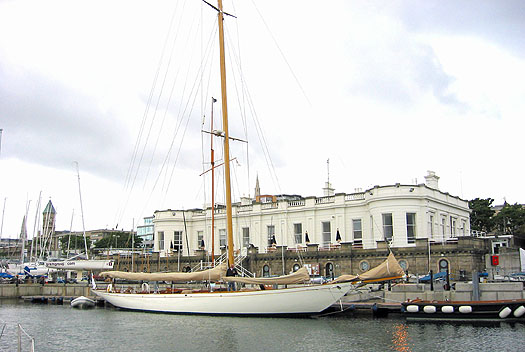
Hallowe'en, course record setter in the 1926 Fastnet Race, at the Royal Irish YC in Dun Laoghaire. Photo: W M Nixon
We know Hallowe'en so very well now, for after an adventurous life on both sides of the Atlantic, she has been restored and is currently owned by an Irish syndicate who from time to time base her at the Royal Irish YC in Dun Laoghaire, though perhaps from respect for her history, the home port inscribed on her elegant transom is Cork. But back in 1926, with a fleet of eight boats racing the second Fastnet, Hallowe'en was so much on her own that despite some strong winds as she cam in past the Lizard heading for the finish, she experienced little of the southeast gale which created mayhem out at the rock, with some boats hove to for a day and more, and Gull – which had been doing rather well, third on the water at the rock – eventually making her dramatic exit towards Cork harbour.
Hallowe'en established a course record which stood until 1939, by which time even larger boats were allowed to compete, and her times was bested by the Kriegsmarine's 88ft Gruber yawl Nordwind, whose German naval crew did not endear themselves to the organizers by their exubernant use of full uniform and Hitler salutes at the prize-giving. In fact, it wasn't until Ted Turner's 12 Meter American Eagle zapped round in style in 1971 that the Hallowe'en course record was beaten by a boat of comparable size. So back in 1926 she was sensational, yet in simply designing to the upper limits, William Fife took no other account of the developing RORC measurement rule, and Hallowe'en had a rating so stratospheric that she finished third on corrected time, the winner being the 20-ton yawl Ilex, sailed by those very determined Royal Engineers.
As for Harry Donegan and Gull, that was their last Fastnet participation, but they were regular contenders in other events, particularly the RORC Falmouth-Clyde races during the 1930s when the skipper's son Young Harry was becoming involved, and of course the skipper himself was involved with huge and infectious enthusiasm for the Irish Cruising Club from its formation in 1929.
In the end, passage races to West Cork and cruising that incomparable area became his fulfilling pleasure, and he'd a final magnificent sail from Schull back to Crosshaven before his death in 1940, aged 70. Death was with the Donegan family again all too soon, for after the war, Young Harry bought one of Cork Harbour's swiftest cruisers, the Clyde 30 Sybil. Gull was sold to the south of England where she ended her days, reportedly as a hulk in Poole Harbour. But with the exciting Sybil, the Donegan offshore racing tradition was hoped to continue, and in 1947 Young Harry and his crew brought her round to Dublin Bay for an ICC offshore race to the Clyde.
The pre-race briefing and party was in the National YC. Like his father, young Harry was a teetotaler, so he was mindful of his crew's safety as the wind was rising, and Dun Laoghaire's open harbour could be dangerously choppy for a dinghy. It proved tragically so. As they were struggling back to Sybil, the dinghy filled, and though Young Harry was heroically successful in ensuring the saving of all his shipmates, his efforts were such that he himself became exhausted, and drowned.
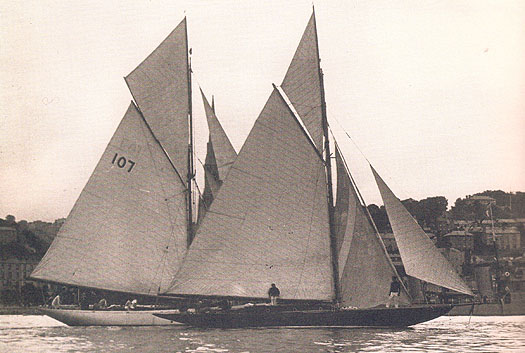
Gull (left) with the Sybil, which Young Harry Donegan bought when he sold Gull to England in 1946. Photo: Courtesy RCYC
It was a massive blow for all Irish sailing, and particularly for the Irish Cruising Club and the closely inter linked sailing community in Cork. But gradually the Donegan inspiration re-asserted itself, and the surname came to the fore in offshore racing again with the late Jim Donegan. Son of young Harry, and grandson of Henry P F Donegan, his successes with the Scampi Half Tonner Yellow Devil (with the Donegan sail number 107), the 36ft White Rooster, and lastly with the First 32s5 Mischief, put the Donegan name firmly back on the trophy boards, while in sailing administration he was the prime mover in founding SCORA (South Coast Offshore Racing Association) and, most importantly of all, in 2002 he became the first Commodore of the new Irish Cruiser Racing Association, which he founded with Fintan Cairns of Dun Laoghaire – it's now one of the most successful bodies not just in Ireland, but in offshore racing worldwide.
But now, there are many Donegans descended from the great Harry Donegan, and several of them sail. Just the same, it is quite something for young Jamie Donegan to be sailing down the Solent tomorrow on Antix, knowing that he is taking part in a globally significant event which his great-great-grandfather was instrumental in founding 88 years ago.
But in fairness, the entire Irish offshore racing community has done its bit in honouring the memory of Harry Donegan and the Gull by racing in the Fastnet as often as possible. Few more so than Denis Doyle with Moonduster, whose childhood memories of visiting the Donegan household on winter Sundays included being put to work with a junior group sanding the many wooden blocks necessary to keep Gull's huge rig under comntrol.
Then there have been other highlights such as the Irish Admirals Cup almost winning in 1979, and Ken Rohan's Regardless winning Class 1 in 1981, and Irish Independent recording the overall win in 1987 when the Admirals Cup team also notched a very creditable fourth.

Ger O'Rourke's Cookson 50 Chieftain from Kilrush sweeps in to Plymouth to win the 2007 Fastnet Race overall in convincing style.
But in the long history of the race, the supreme Irish moment has to be Ger O'Rourke's clear overall win with Chieftain in 2007. Like the rest of us, life has had its ups and downs for Ger since 2007. But that glorious supreme win is one of the greatest highlights of Irish sailing history.
So with a dozen Irish boats in the pot this year, who can we expect to figure in the final listings? Defending holder of the Gull Salver for the best-placed Irish boat in the Fastnet is the J/133 Spirit of Jacana from Carrickfergus, campaigned by the Douglas brothers, and they're going again. Much will also be expected of Antix, as her skipper is an RORC Flag Officer, and she's a proven winner. And though the Galway Reflex 38 sometimes known as Lynx has had a mixed season, over a series of events including the ICRA Championship and the Sovereigns her overall performance has been tops.
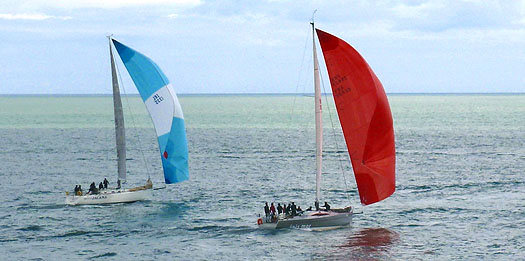
Spirit of Jacana and Inis Mor in the Round Ireland Race 2012. Both are comppeting in tomorrow's Fastnet Race. Photo: W M Nixon
More important with every year in the RORC programme is the two-handed division, and here we have a very strong interest with Andy Boyle of Dun Laoghaire who sails with Nick Martin on the J/105 Diablo-J. They won the Round Ireland Race in this division last year, and they've been right in the frame throughout this year's programme – very much a boat to watch in a division in which the competition will include young David Kenefick of Crosshaven and Olaf Sorensen of Kinsale in the Figaro II.
But with 380 boats making their westward out of the Solent tomorrow, it's anybody's guess for the class wins as much as the overall titles. So taking them alphabetically is as good as sticking in a pin hile blindfold, and here are the boats with special Irish interest, good luck to all of them.
Adelie (First 34.7, Peter Hall, NYC)
Alchimiste (JPK 9.60, Mike Murphy, KYC)
Antix (Ker 39, Anthony O'Leary, RCYC)
Aquelina (J/122, James & Sheila Tyrrell, Arklow SC)
Figaro II (Figaro, David Kenefick RCYC)
Diablo-J (J/105, Nick Martin/Andy Boyle, RORC)
Inis Mor (Ker 39, Laurent Gouy, Clifden BC),
Jedi (J/109, Andrew Sarratt, Dun Laoghaire)
Joker (J/109, Chris Andrews, Dun Laoghaire)
Lula Belle (First 36.7, Liam Coyne, NYC)
Lynx Clipper/The Gathering (Reflex 38, Aodhan Fitzgerald, GBSC),
Spirit of Jacana (J/133, Alan, Bruce & James Douglas, Carrickfergus SC.
Tonnere de Breskens (Ker 46, Piet Vroon, RORC)































































